Johanna von Monkiewitsch
„arisen“
16 Nov – 15 Dec 2019
Installation Views (for English and German exhibition text scroll downwards)
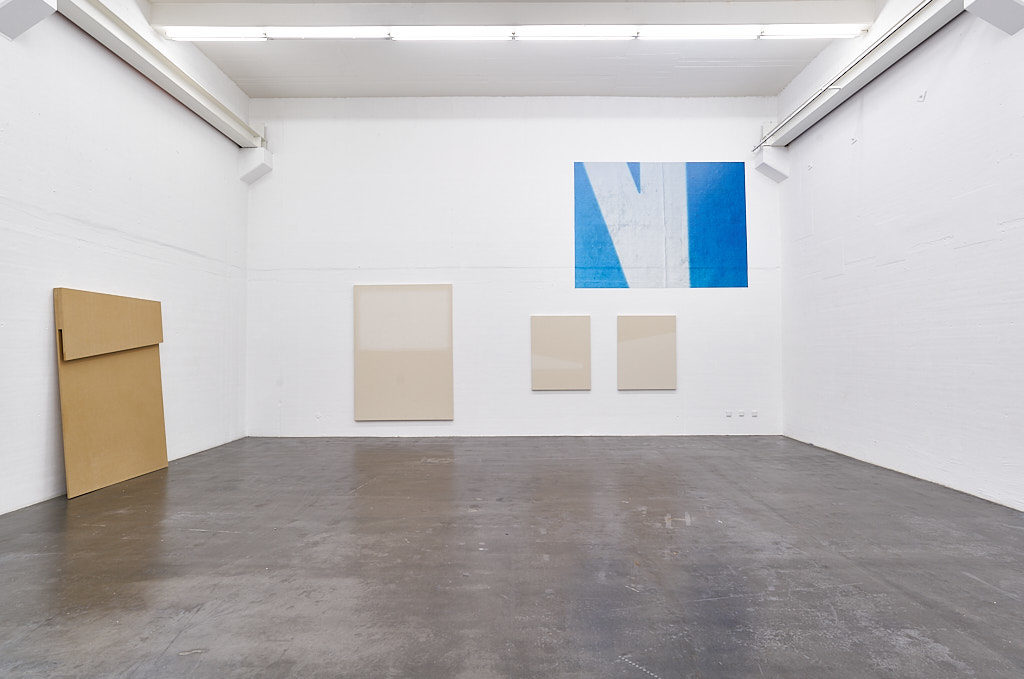
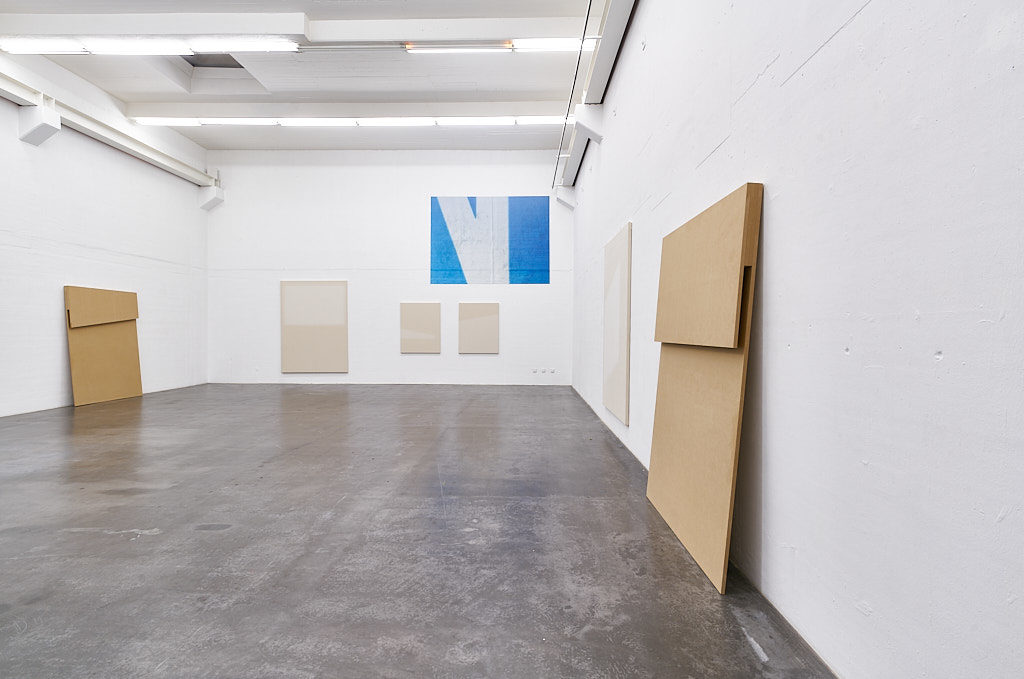

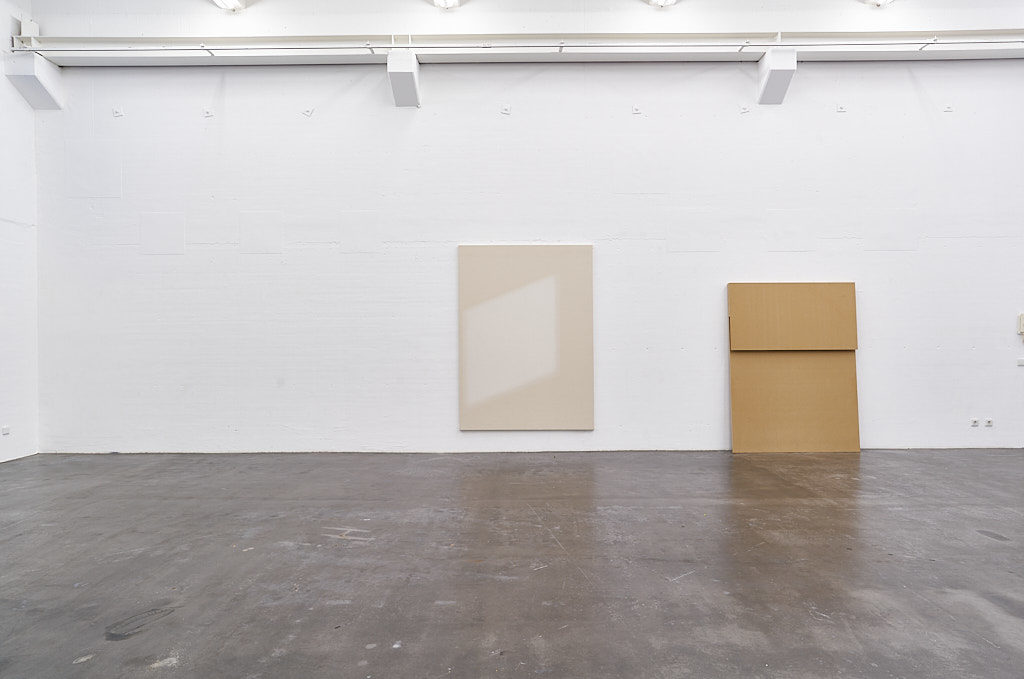

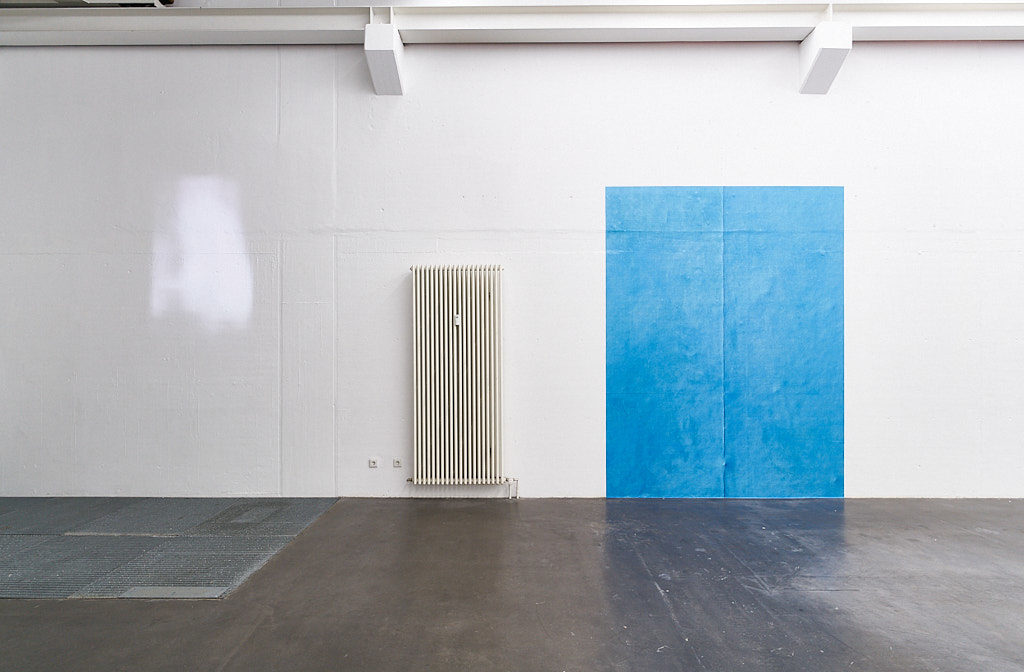


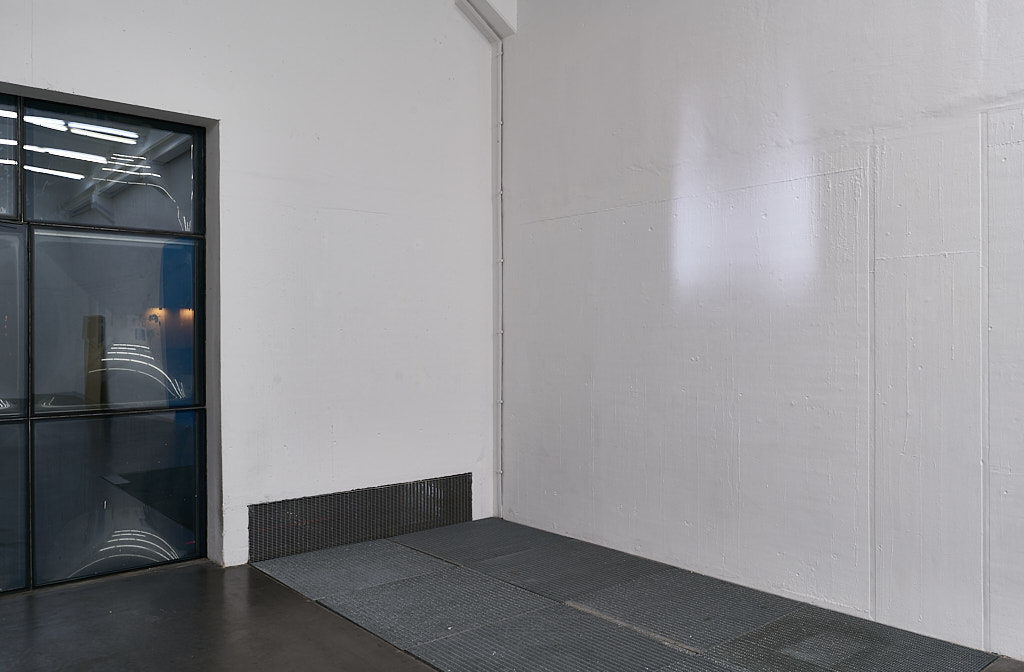

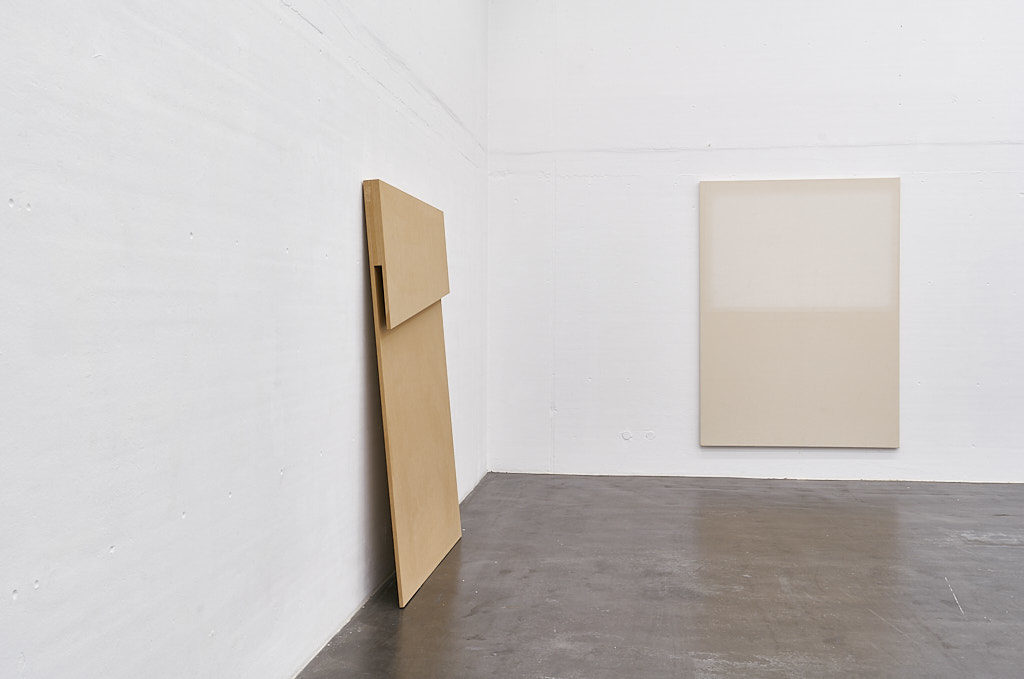

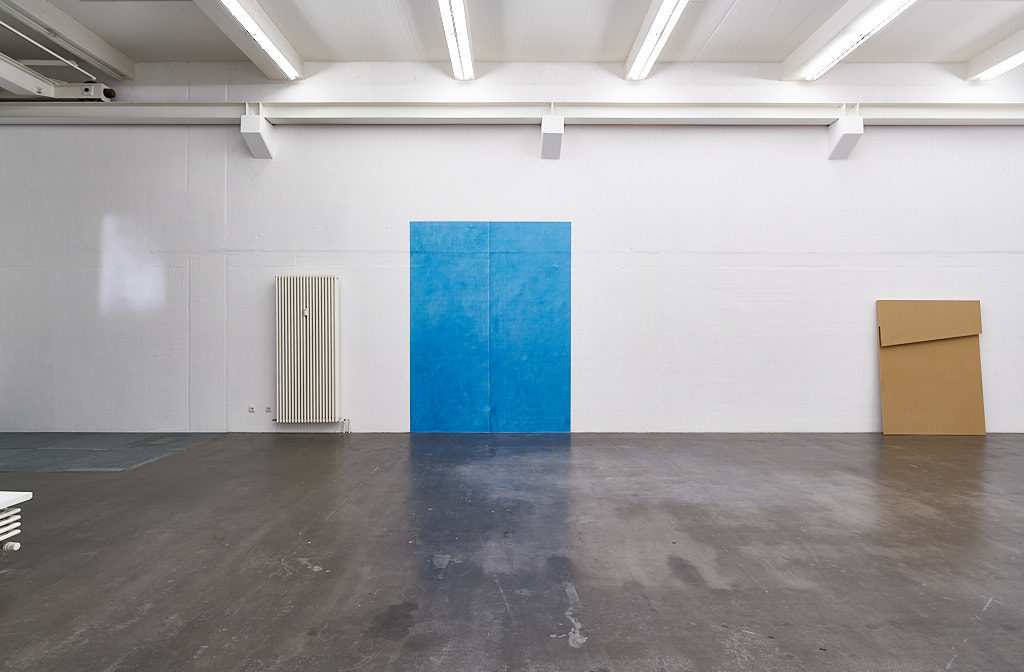
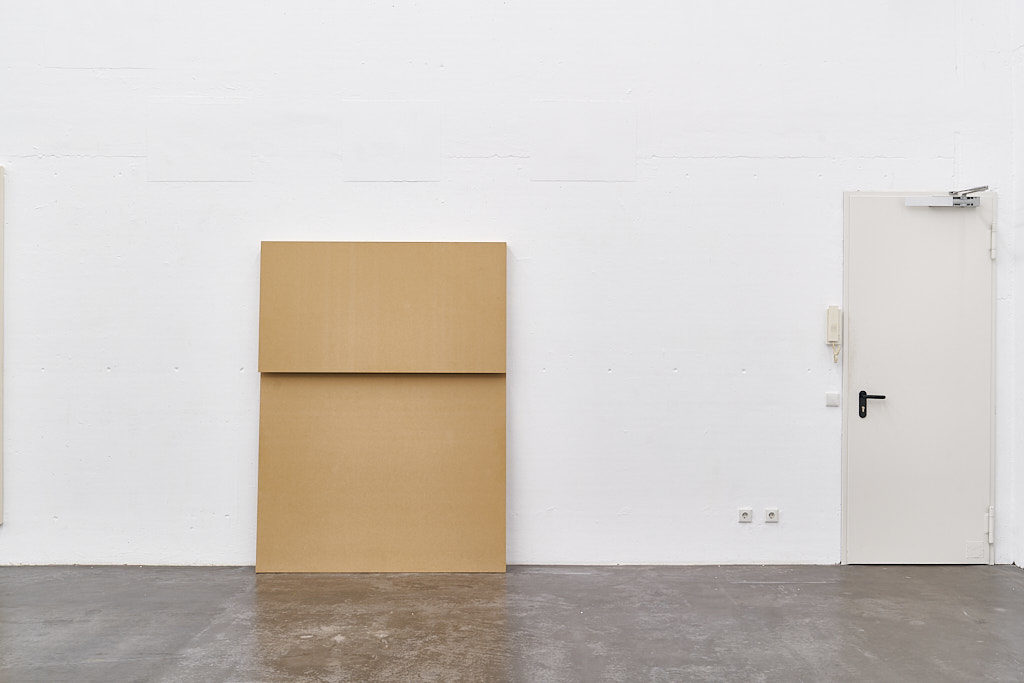

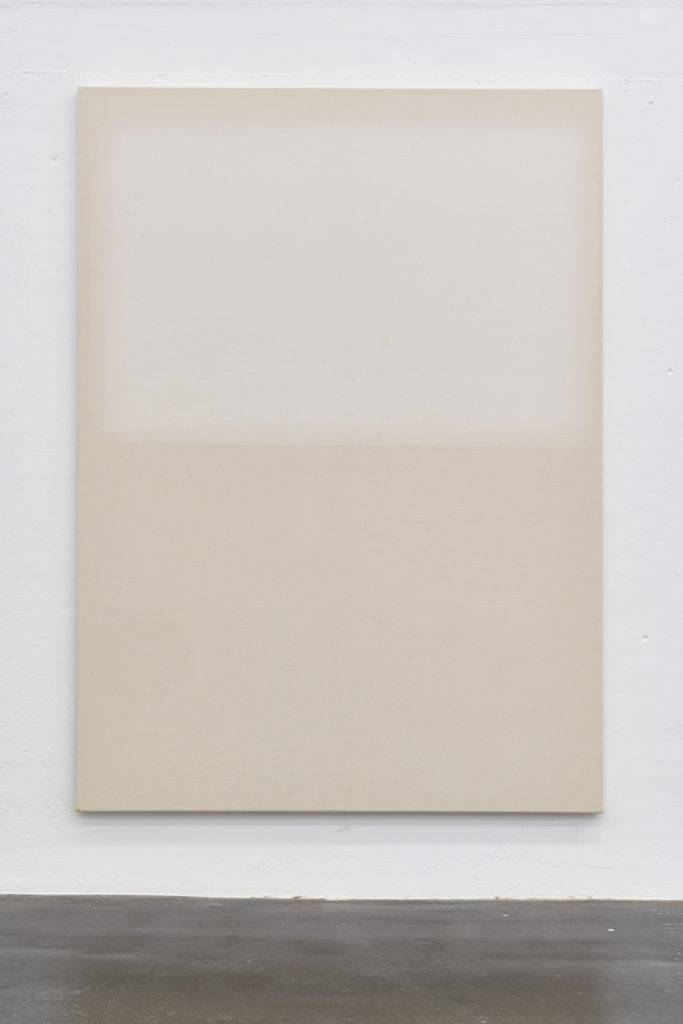
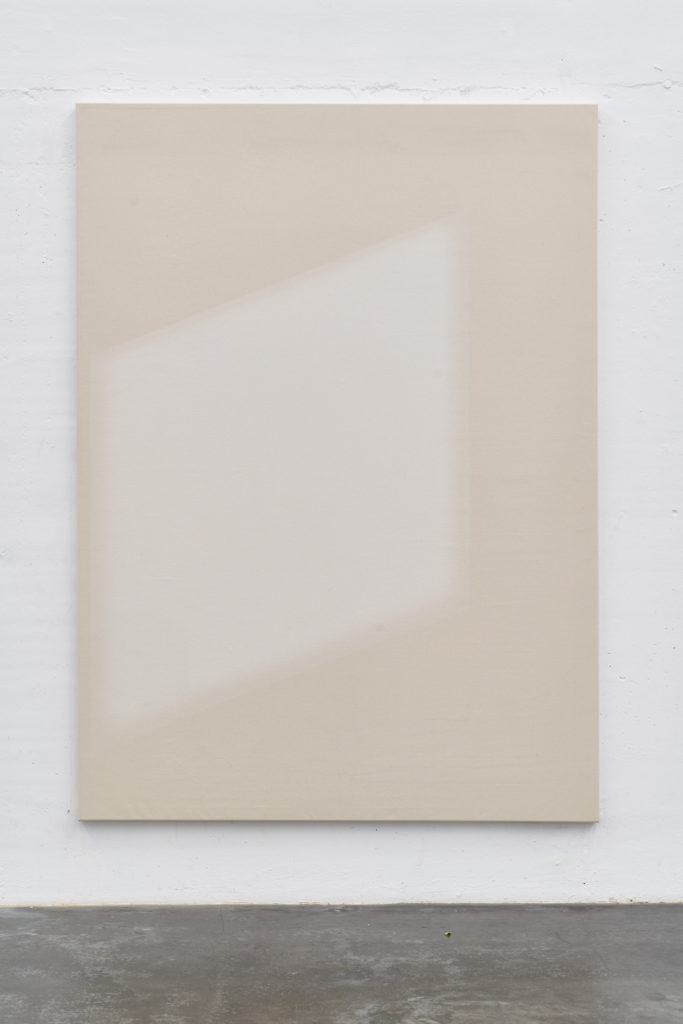

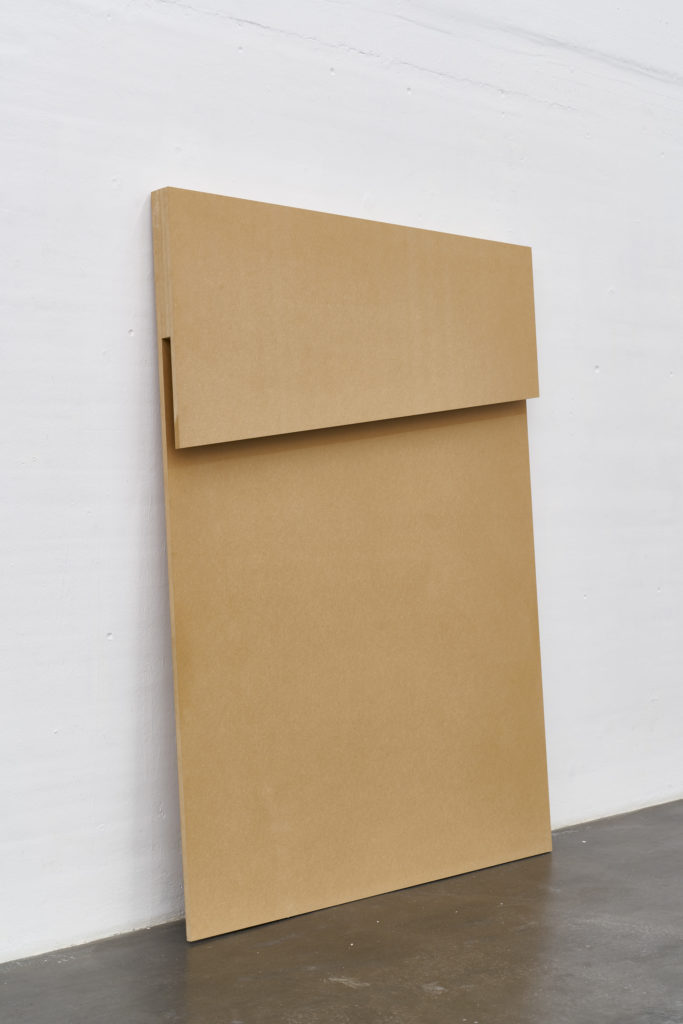

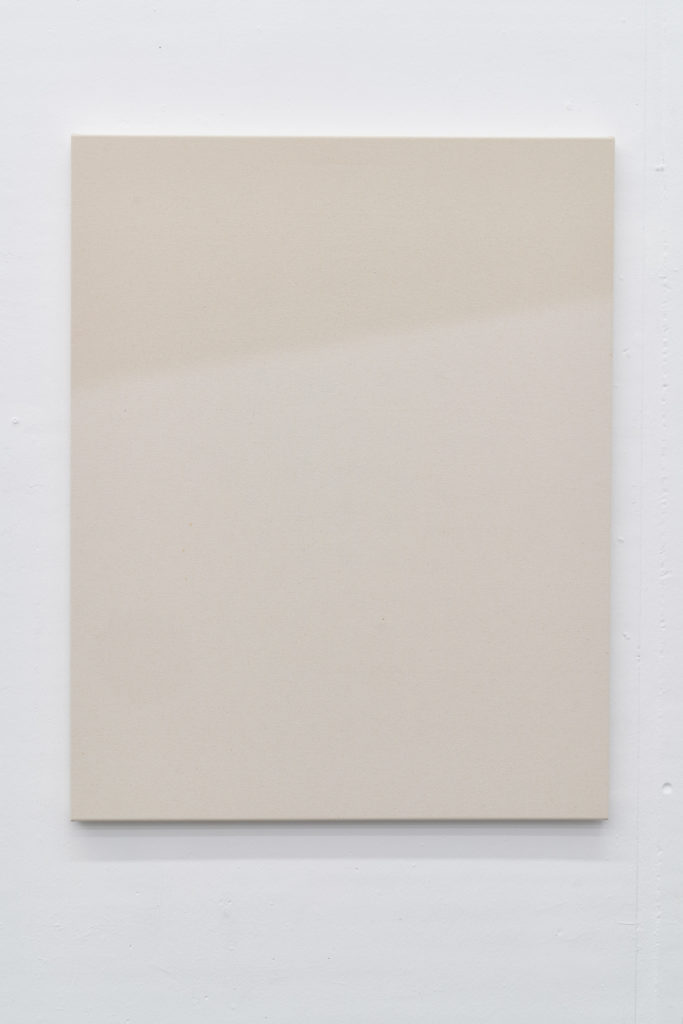
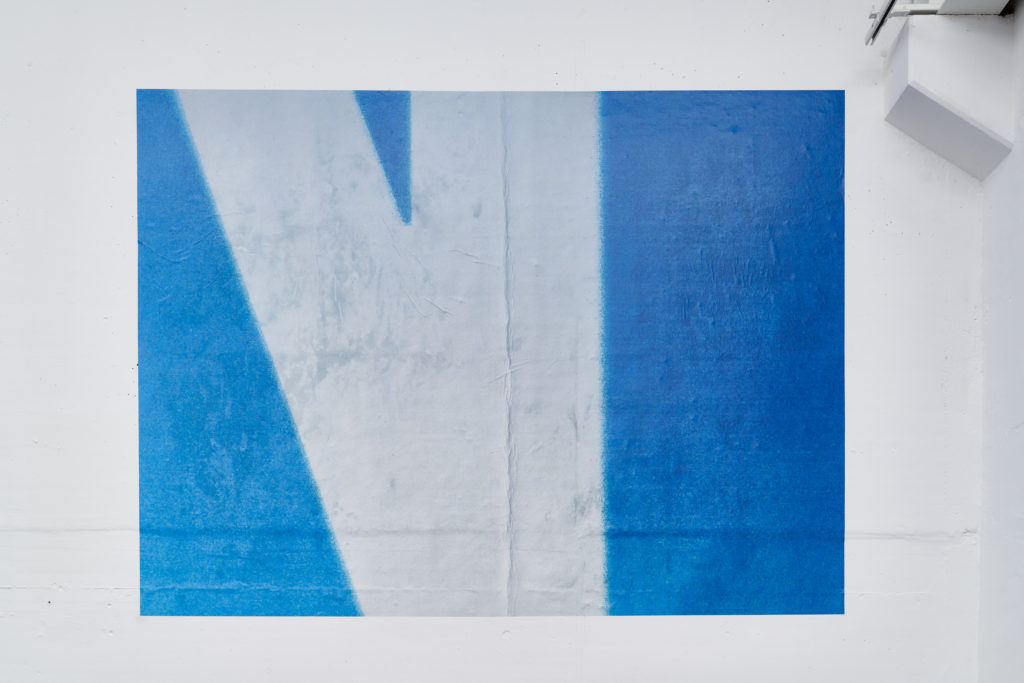
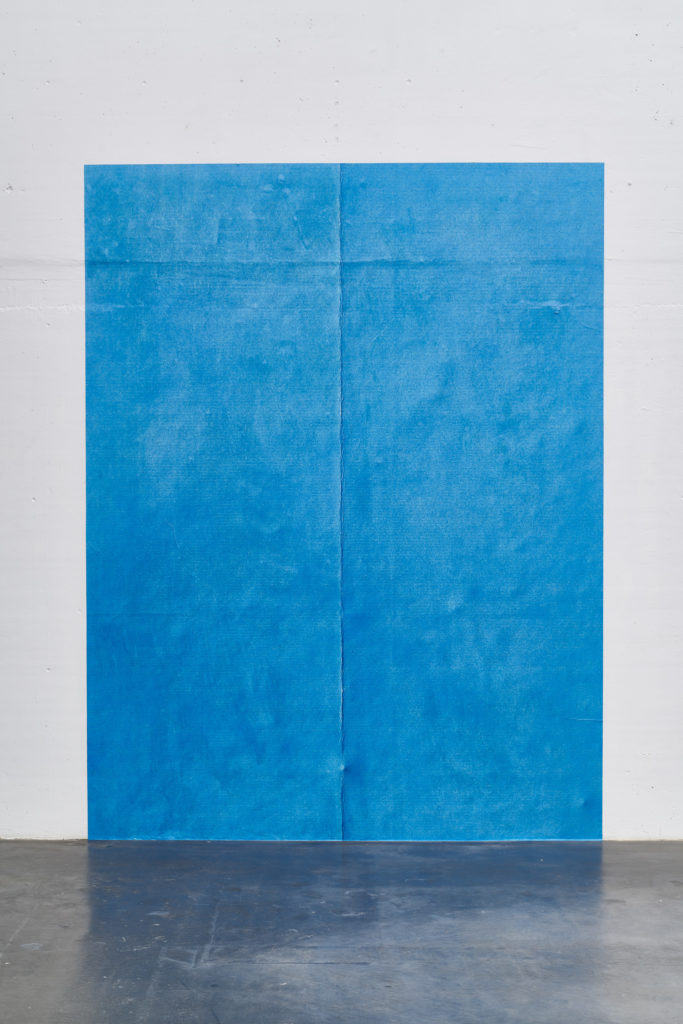
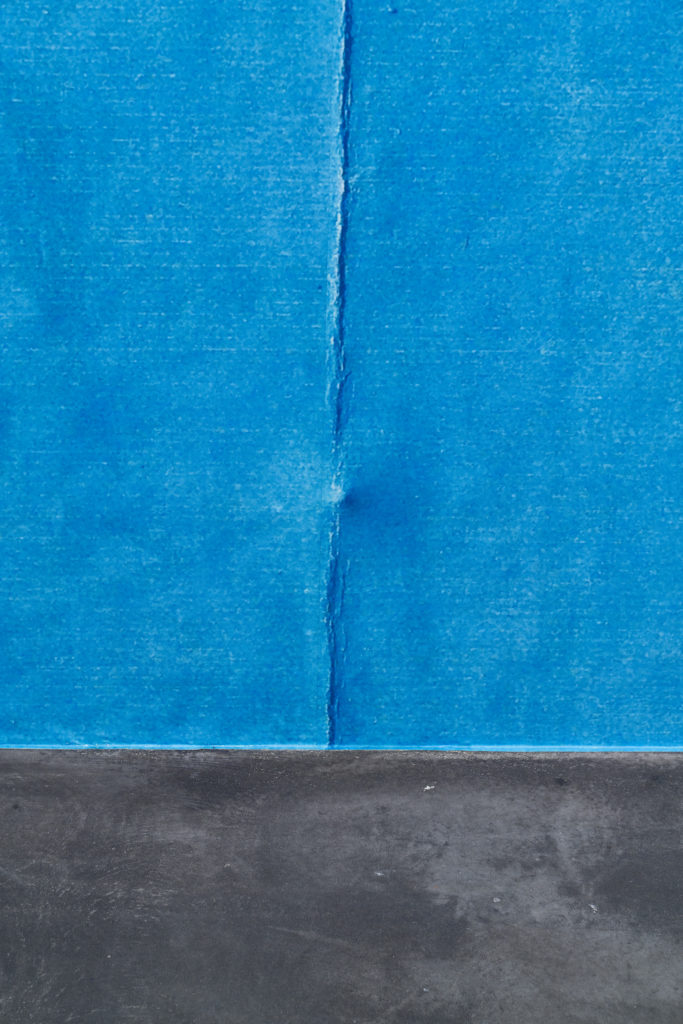


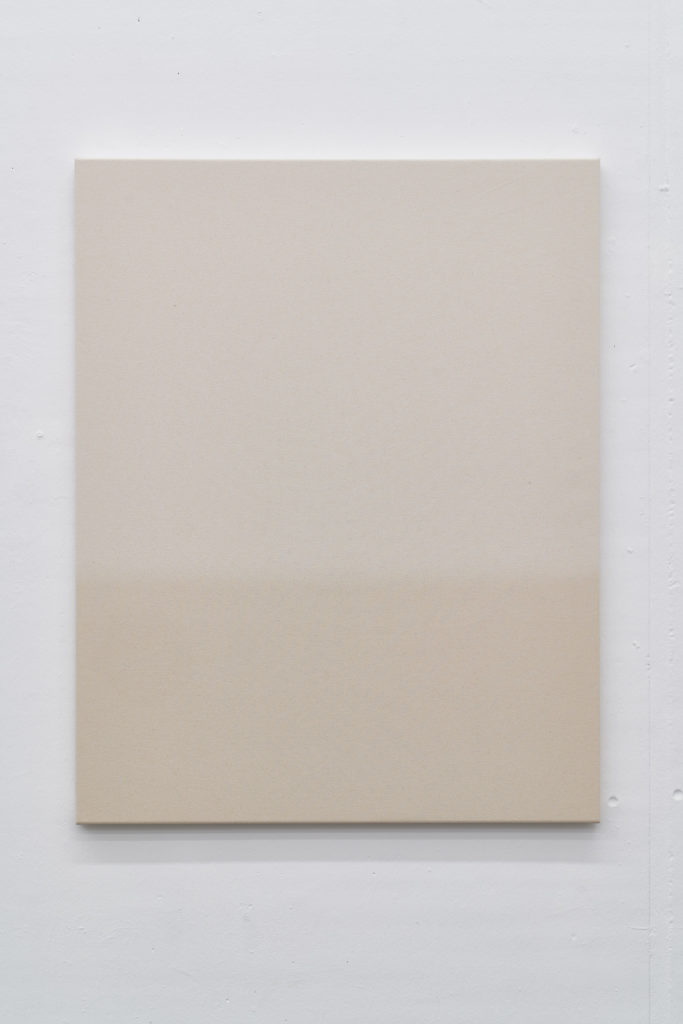

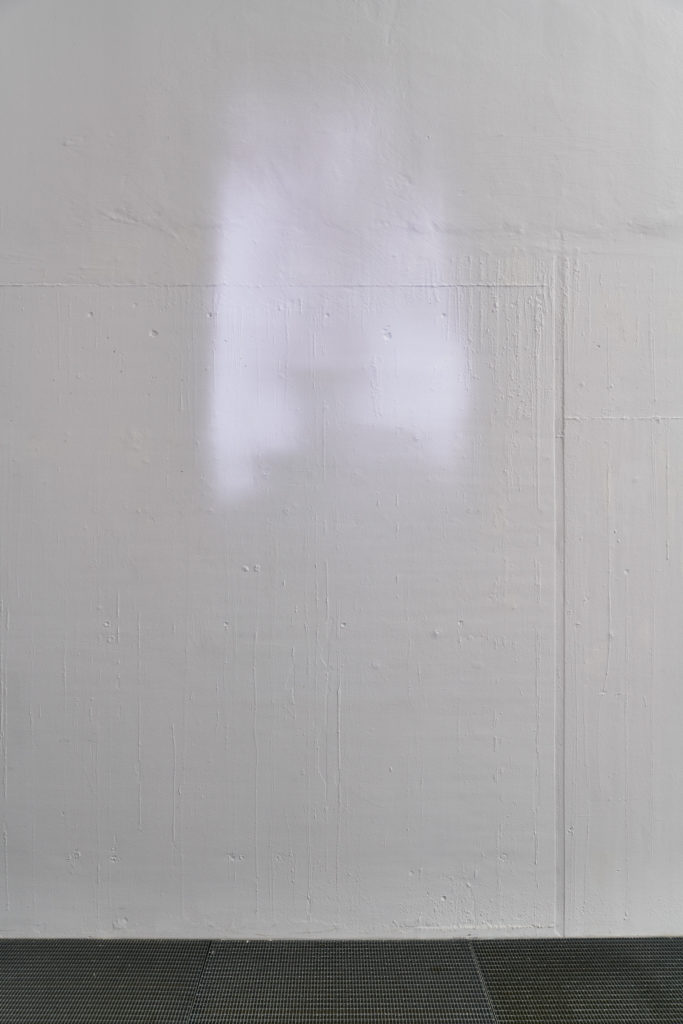
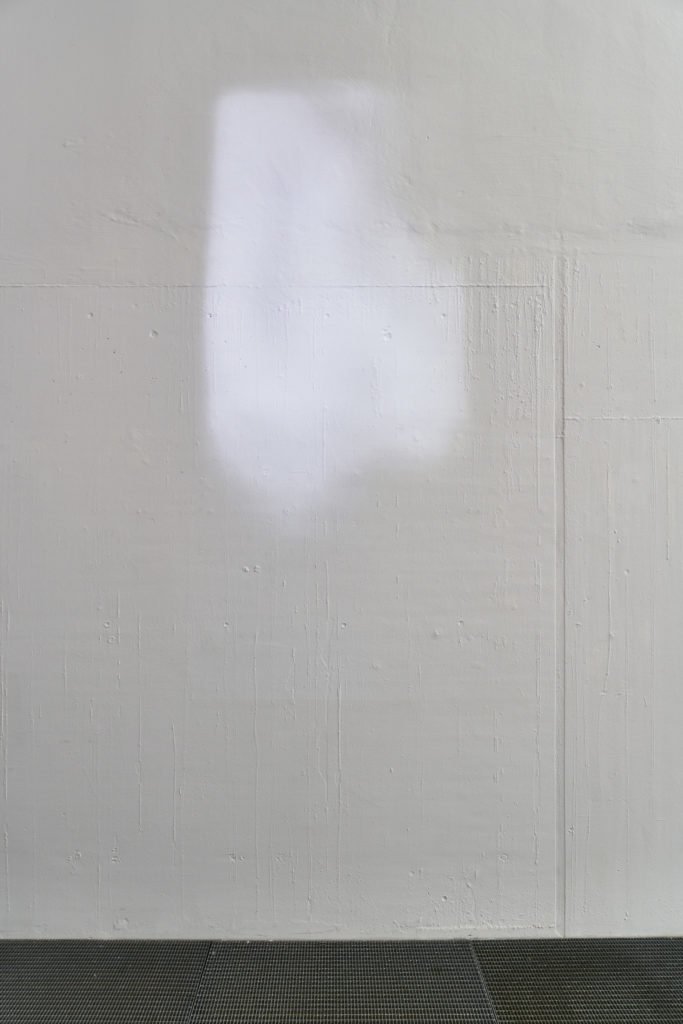
Exhibition Text English (for German version scroll downwards)
Johanna von Monkiewitsch could be described as a ‘Licht-Bildner’ or ‘light sculptor’ (see: Stephan Berg, Rittrato/Copia, Museo Ca’Rezzonico, Venice, 2017). And with her new series of canvases, she once again does justice to this description. In her usual minimalist manner, both in terms of the visual language and the use of resources, she now works with canvases for the first time. In the current exhibition, titled arisen, she presents four works in which light-white geometric forms emerge on dark-white canvases, reminiscent of light entering a space through a window. And indeed, the process of creating the works confirms this impression. Covering parts of the canvases, the artist exposed them to the sun of Sardinia for several weeks. Not the artist’s application of paint or gesture, but the energy of the sun creates an image in which the impermanence of the material also suggests the aspect of transience.
Time and again, Johanna von Monkiewitsch addresses the interplay of light and shadow. The surfaces of her new wall sculptures made of MDF also create shadow surfaces in their corners and fissures. In addition, the artist has applied shadow illusions to the material with dark pigments that capture a certain moment at which the shadow in her studio drew exactly these lines and which now create a confusion with the actual shadows cast. Image and reproduction, the real and the illusionary can hardly be separated from each other. What is genuine about what we see, what is illusion?
In the current exhibition, von Monkiewitsch introduces another new series of works which she calls Billboards. Using her mobile phone, she photographed parts of large-format advertising posters in the city, which in turn have been enlarged and printed on poster paper. Image content and image carrier are thus identical. The artist has wallpapered two of these blue-and-white works, over three metres in size, on the gallery wall, one very high, close to the ceiling, the other flush with the floor. The entire gallery space is utilised, the classical principle of the hanging of pictures at eye-level is thwarted. From a distance, these Billboard works appear as graphic compositions, coloured surfaces and cut-off letters stand side by side. A closer look reveals the creases, dents and folds that were on the posters and that the artist captured in the photograph. The wallpapered poster panels appear like a second skin on the gallery wall. Unevenness, dents and joints in the concrete wall press through the paper, so that photographed material surfaces and actual surfaces overlap.
As the fourth medium – alongside photos on poster paper, MDF sculptures and bleached canvases – von Monkiewitsch is presenting a video projection, which was created during her fellowship at the German Study Centre in Venice. In this city, the intensity of light is especially high, and the incidence of light is particularly versatile due to the narrow alleys, canals, palazzi and squares. On a wall, the artist discovered a patch of sunlight reflected from the water surface of the canal into the building – iridescent and constantly in motion due to the dynamics of the waves – and filmed this. This approximate two-minute-long, transient ‘light image’ was thus preserved and can be reproduced again and again. The artist has now projected it onto the gallery wall with a beamer, where it moves like an immaterial, intangible sculpture in an almost dance-like manner, constantly taking on new, changing forms before the loop begins after again.
The exhibition thus features a wide variety of light constellations and materials: from the sculptural-spatial to flat, from static moments to moving sequences of light. These include the most diverse properties of light, which the artist has deliberately combined and placed next to each another or in groups: Different angles of incidence (e.g. diagonal or frontal) and light intensities (from soft, fog-like light clouds to hard shadow edges) create an irrational image that eludes rational classification and regularity. A kind of ‘light-image-reproduction’ collage of intangible arrangement interweaves itself in and with the space!
Biography:
Johanna von Monkiewitsch (born 1979 in Rome, lives and works in Cologne) studied Fine Art at the Braunschweig University of Art (HBK). In recent years, her works have been presented in exhibitions at the Kölnischer Kunstverein in Cologne, the Kunstverein Wolfenbüttel, the Kunstraum Alexander-Bürkle in Freiburg, the gallery Berthold Pott in Cologne and the Museo Ca’Rezzonico in Venice (museum support programme of the Venice Biennale 2017). She received, among others, a grant from the Kölnischer Kunstverein, a work scholarship from the Kunstfonds Bonn, a fellowship from the German Study Centre in Venice and recently the scholarship „Bremerhaven Stipendium“ for 2020/21. For the last two years, she has worked as an Assistant Professor at the Düsseldorf Academy of Art.
Exhibition Text German:
Johanna von Monkiewitsch könnte man auch als „Licht-Bildnerin“ bezeichnen (vgl. Stephan Berg, „Rittrato/Copia“ Museo Ca´Rezzonico, Venedig, 2017) und mit ihrer neuen Serie an Leinwänden wird sie dieser Beschreibung wieder gerecht. In gewohnt minimalistischer Weise, sowohl was die Bildersprache, als auch den Einsatz der Mittel angeht, arbeitet sie erstmalig mit Leinwänden. In der aktuellen Ausstellung „arisen“ zeigt sie vier Arbeiten, auf denen sich hell-weiße geometrische Formen auf dunkel-weißer Leinwand abzeichnen, die an einen Lichteinfall durch ein Fenster im Raum erinnern. Und tatsächlich bestätigt der Entstehungsprozess der Arbeiten diesen Eindruck. So hat die Künstlerin die Leinwände über mehrere Wochen der Sonne Sardiniens ausgesetzt und dabei Teile der Leinwand abgedeckt. Nicht Farbauftrag oder Geste der Künstlerin, sondern die Energie der Sonne erschafft ein Bild, in dem sich mit der Unbeständigkeit des Materials auch der Aspekt der Vergänglichkeit andeutet.
Das Zusammenspiel von Licht und Schatten thematisiert Johanna von Monkiewitsch immer wieder. Auch die Flächen ihrer neuen Wandskulpturen aus MDF schaffen in ihren Winkeln und Spalten Schattenflächen. Zusätzlich hat die Künstlerin mit dunklen Pigmenten Schattenillusionen auf das Material aufgetragen, die einen bestimmten Moment festhalten, an dem der Schatten in Ihrem Atelier genau diese Linien zeichnete und die nun mit den tatsächlichen Schattenwürfen ein Verwirrspiel treiben. Bild und Abbild, Reales und Illusionäres sind kaum noch von einander zu trennen. Was ist wahrhaftig an dem, was wir sehen, was ist Illusion?
In der aktuellen Ausstellung führt von Monkiewitsch eine weitere neue Serie von Arbeiten ein, die sie „Billboards“ nennt. Mit dem Handy hat sie Teile von großflächigen Werbeplakaten in der Stadt abfotografiert und diese wiederum in Ausschnitten vergrößert auf Plakatpapier ausgedruckt. Bildinhalt und Bildträger sind somit identisch. Zwei dieser blau-weißen, über drei Meter großen Arbeiten hat die Künstlerin auf die Galeriewand plakatiert, eine davon sehr hoch, deckennah, die andere bis zum Boden reichend und bündig abschließend. Der Galerieraum wird in Gänze bespielt, das klassische Augen hohe „Hängeprinzip“ des Bildes durchbrochen.
Von weitem erscheinen diese Billborad-Arbeiten wie grafische Kompositionen, Farbflächen und angeschnittene Buchstaben stehen nebeneinander. Bei näherer Betrachtung entdeckt man vor allem die Knicke, Beulen und Falzungen, die auf den Plakaten waren und die die Künstlerin im Foto festgehalten hat. Die tapezierten Plakatbahnen erscheinen wie eine zweite Haut auf der Galeriewand. Unebenheiten, Beulen und Fugen in der Betonwand drücken sich durch das Papier, fotografierte Materialoberflächen und tatsächliche Oberflächen überlagern sich.
Als viertes Medium – neben Foto auf Plakatpapier, MDF-Skulpturen und gebleichten Leinwänden – zeigt von Monkiewitsch Videoprojektion, die während Ihres Stipendiums im Deutschen Studienzentrum in Venedig entstanden ist. In dieser Stadt ist die Lichtintensität besonders hoch und die Lichteinfälle bedingt durch die engen Gassen, Kanäle, Palazzi und Plätze besonders vielseitig. Ein von der Wasseroberfläche des Kanals in ein Gebäude gespiegeltes Sonnen-Licht, changierend und ständig in Bewegung durch die Wellendynamik des Wassers, hat die Künstlerin an einer Wand entdeckt und abgefilmt. Somit wurde dieses ca. zweiminütige Lichtbild erhalten und kann stets wieder reproduziert werden. Die Künstlerin hat ihn nun mit dem Beamer an die Galeriewand projiziert, wo er sich wie eine immaterielle, nicht greifbare Skulptur fast tänzerisch bewegt, und dabei immer neue, wechselnden Formen einnimmt, bevor nach zweieinhalb Minuten der Loop einsetzt.
In der Ausstellung finden sich also ganz unterschiedliche Lichtkonstellationen und Materialien: von skulptural-raumgreifend bis flach, von statischen Lichtmomenten hin zu bewegten Lichtverläufen. Diese beinhalten unterschiedlichste Lichtgesetzmäßigkeiten, die die Künstlerin bewusst miteinander kombiniert und nebeneinander oder in Gruppen gestellt hat: unterschiedliche Lichteinfallswinkel (wie z.B. schräg oder frontal), Lichtintensitäten (von weichen, nebelartigen Lichtwolken bis zu harten Schattenkanten) kreieren ein irrationales Bild, welches sich einer rationalen Einordnung und Gesetzmäßigkeit entzieht. Eine Art Licht-Bild-Abbild Collage nicht greifbarer Anordnung verwebt sich in und mit dem Raum!
Biographie:
Johanna von Monkiewitsch (geb. 1979 in Rom, lebt u. arbeitet in Köln) hat an der HBK in Braunschweig Freie Kunst studiert. Ihr Werk umfasst die Genres Video, Fotografie, Skulptur, Leinwand- und Papierarbeiten. In den letzten Jahren war sie z.B. in Ausstellungen im Kölnischen Kunstverein, im Kunstverein Wolfenbüttel, im Kunstraum Alexander-Bürkle in Freiburg, in der Galerie Berthold Pott in Köln oder im Museo Ca´Rezzonico in Venedig (Museumsrahmen-Programm der Venedig Biennale 2017) zu sehen. Im Jahr 2020 wird sie eine Einzelausstellung im Kunstverein Bochum haben, 2021 eine Einzelausstellung in der Kunsthalle Bremerhaven. Sie erhielt u.a. das Stipendium des Kölnischen Kunstvereins, das Arbeitsstipendium Kunstfonds Bonn, das Stipendium des Deutschen Studienzentrum in Venedig und gerade das „Bremerhaven Stipendium“ 2020/21. In den letzten zwei Jahren war sie als Assistent Professor an der Kunstakademie in Düsseldorf beschäftigt.